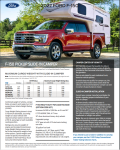Todd780
OverCamper
I had a few conversations with Brian, head of north American f series, over my truck order. We spent time on this. My truck was to have a 4900 lb payload. His literature stated in two areas , 4900 and 4000 for my truck. When the truck showed up my payload was 4741 lbs. The difference between a couple of options added and the first number. Crew, there is a reason Ford stopped producing Brochures in July of this year, it wasn't just to save money. The literature was filled full of misinformation and when pressed on this, Brian got really quiet. I told him to hire me just to check for continuity.
Speaking of misinformation, the chart refercing weights of HDPP's.... Kind of funny the truck pictured is of a 145" wheelbase 502a Lariat. Since you can't get HDPP on a Lariat or on any 145" wheelbase F150. I'd guess the truck on the chart as pictured with that camper, would have been overweight.The chart says each available seat, so I'd venture that regular cabs are calculated with 3 seats, super and crew cabs with 6 seats - so 450 lbs of passengers for a regular cab and 900 lbs of passengers for the supercab and crew cab. Since Ford requires the HDPP for any F150 with a truck camper, those numbers (with added weight for passengers) seem to roughly add up to max payload stickers on HDPP trucks - based on memory since I don't have a chart in front of me.




